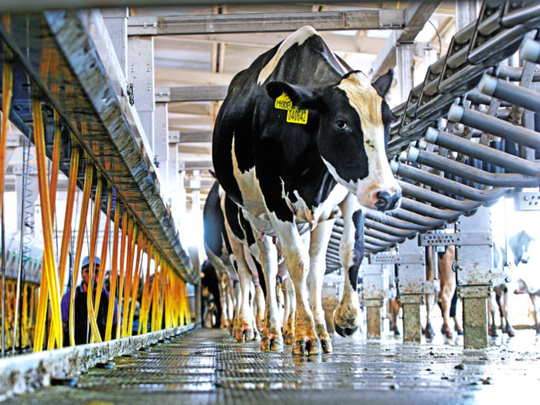
While the consumption of dairy has always been considered healthy in the UAE, it’s an endless variety of innovative dairy products — low-fat, vitamin-enriched, lactose-free and organic — that seems to be driving demand these days.
The UAE dairy industry has witnessed rapid growth in the past few years, fuelled by an expanding economy and fast-paced increases in population and tourist numbers. “In 2012, the total UAE consumption of liquid milk reached approximately 210 million litres. Short-life milk represented 60 per cent of total consumption,” says Mahboob Murshed, Managing Director at Alpen Capital (ME) Limited, which carries out industry studies and offers a range of economic and financial forecasts on selected industries relevant to GCC economies.
The GCC market
Among the GCC countries, Saudi Arabia is the largest producer of milk and dairy products, followed by the UAE and Oman. Saudi Arabia produces around 50 per cent of the milk and milk products the country consumes locally, while the UAE produces approximately 25 per cent of its domestic demand, says Murshed. Qatar, Oman, Kuwait and Bahrain produce less than 20 per cent of their overall dairy consumption.
“We expect the entire GCC dairy market to grow at a healthy pace over the coming three years,” adds Murshed. “Compared to high dairy consuming countries in the West, the per capita consumption of dairy products in GCC countries is still much lower, which indicates that there is significant room for further growth.”
Though a significantly bigger segment of consumers now rely on ultra-heat treatment (UHT) and canned milk for the convenience of storage and utilisation, the demand for fresh milk is still robust. “In the UAE, sales of UHT and canned milk are growing at annual rates of 5 per cent and 3 per cent,” says Sumeet Mathur, Marketing Director at FrieslandCampina Middle East, the maker of Rainbow Milk and other brands. “A long shelf life makes UHT milk a popular choice. It can stay for months without refrigeration. Parents always opt for UHT milk for children’s lunch boxes, as they can be consumed straight out of the packs without boiling,” he adds.
Milk consumption patterns in the UAE have changed considerably in the past couple of decades. Mathur says consumers have become sophisticated and started using different formats to meet varying needs. “While in the 1950s, consumers used to drink Rainbow Evaporated Milk directly from cans owing to lack of availability of fresh milk, today they use it mainly with tea or coffee and opt for only fresh milk and UHT for drinking. They choose powdered milk for cooking and sweetened condensed milk for desserts,” he says.
More variants
The demand for goat’s and camel’s milk has also picked up in the past few years. “We have been seeing a steady upward trend in the demand for goat’s and camel’s milk, as well as their by-products, such as goat cheese, flavoured camel milk and chocolates made from camel milk. This is not to say these alternatives are anywhere close to the demand for cow’s milk,” says Waeel Barjhi, Deputy General Manager, Marmum Dairy Farm. As consumers look for products that fit their lifestyle, dietary and nutritional requirements, the industry is focusing on healthier options. Low-fat, calcium-rich and lactose-free variants, for instance, are seeing a rise in sales. Companies, local and international, have launched products that meet the needs of young consumers.
“Rising health awareness in the region, the UAE in particular, where a growing number of Western expatriates are bringing with them their consumption habits, has led to a surge in sales of healthy products,” Sana Toukan, Research Manager Middle East, Euromonitor, tells GN Focus. Awareness campaigns by governments in the region about obesity and healthy eating have also encouraged people to choose products wisely. “Though the category is still very niche, it is growing fast. Reduced-fat dairy has witnessed a 5.5 per cent value growth in 2012 in the UAE,” she adds.
As product extension is key to growth in the competitive dairy industry, companies in the UAE are investing significantly on constant innovation, packaging and marketing.
Rainbow Milk has rolled out a range of flavoured evaporated milk in the past few years in the UAE. “People from the Indian subcontinent and the Middle East love a flavour of cardamom in their beverages and to cater to them, we launched the cardamom-flavoured evaporated Rainbow Milk. To help consumers add a richer taste to beverages, we introduced Rainbow Gold and to address their lifestyle needs, we also launched low-fat and low-cholesterol evaporated milk. We have to listen to consumers and also anticipate some of their unexpressed needs to grow in this competitive market,” says Mathur.
Al Rawabi Dairy invested Dh100 million last year to increase its farm facilities and production capacity. “We recently introduced flavoured milk in the market. We invest a lot of capital in product innovation and work to improve our products to meet the current market trends and demand. The UAE market is becoming very competitive and to stay ahead of our competitors we have to evolve in terms of our product offering,” says Abyson Jacob, Deputy Sales and Marketing Manager, Al Rawabi.
However, competition from global manufacturers and escalating costs do pose challenges for local producers. “The lack of a more engaging and supportive mechanism to protect the interests of local producers against the massive capacities of global manufacturers affects our business,” says Barjhi of Marmum Dairy.











